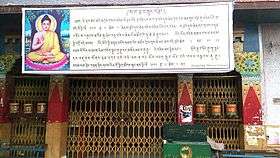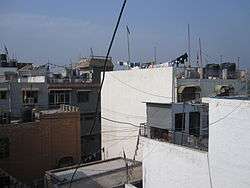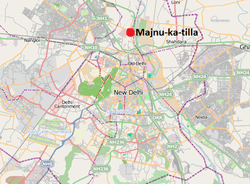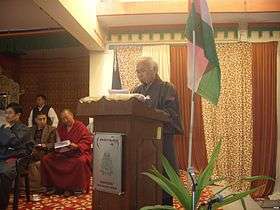Majnu-ka-tilla

| Majnu-ka-tilla New Aruna Nagar Colony, Samyeling | |
|---|---|
| Neighbourhood | |
 View from rooftop in Majnu-ka-tilla | |
 Location of Majnu-ka-tilla in Delhi | |
| Coordinates: 28°42′05″N 77°13′41″E / 28.70137°N 77.22816°ECoordinates: 28°42′05″N 77°13′41″E / 28.70137°N 77.22816°E | |
| Country |
|
| State | Delhi |
| District | North Delhi |
| Established | 1960 |
| Population (2000)[1] | |
| • Total | 2,500 |
| Time zone | UTC+5:30 (Indian Standard Time) |
| Pincode(s) | 1100054[2] |
| Area code(s) | +91 11 |
Majnu-ka-tilla (MT) is a colony in Delhi, India that was established around 1950.[note 1] Majnu-ka-tilla is officially called New Aruna Nagar Colony,[5] Chungtown,[3] and Samyeling.[6] It is part of North Delhi district and is located at the bank of the Yamuna River (NH-1) near ISBT Kashmiri Gate.
History
The historic name of area, literally means the hillock of Majnu, after the tilla or mound where during the reign of Sikandar Lodhi (r. 1489–1517) on Delhi Sultanate, a local Iranian Sufi mystic, Abdulla nicknamed Majnu (lost in love), met Sikh Guru, Guru Nanak on 20 July 1505. Majnu ferried people across the Yamuna river for free as a service to God, his devotion resulted in the Nanak staying here till end July. In later history Sikh military leader Baghel Singh built the Majnu ka Tila Gurudwara to commemorate the stay in 1783, and the sixth Sikh guru, Guru Har Gobind also stayed here. Today it is one of oldest extant Sikh shrines in Delhi and the surrounding estate of donated by early 19th-century Sikh emperor, Ranjit Singh.[7][8][9]
Majnu Ka Tilla area has three main residential settlements with total 3000–3500 homes, Aruna Nagar, New Aruna Nagar and Old Chandrawal village, which was built up in early 1900s, when British government settled labourers involved in the construction of the Central Secretariat buildings, during the construction of the New Delhi. The next round of settlement came post-independence in 1958-59, when Aruna Nagar was developed by the Land and Development wing of the Ministry of Urban Development as it disburses 925 plots of 40 sq. yard each, to people resettled here from various part of North Delhi. The Tibetan refugee camp later named New Aruna Nagar developed after 1960.[9]
Tibetan settlement: 1960 to present
Just as Aruna Nagar was developing, the 1959 Tibetan uprising took place in March, most residents of Majnu-ka-tilla left Tibet in 1959-60, when the Dalai Lama too went into exile to Dharamshala. Soon, a small Tibetan refugee camp up across the road, on the Yamuna riverbed.[1][9] The land was allotted by the Government of India to the refugees in 1960.[10] After the Sino-Indian War in 1962, many of the refugees who had previously settled temporarily near the Indo-Chinese border shifted here.[9] Today, it is home to second generation of Tibet refugees and is also known as Samyeling, through colloquially as "Little-Tibet" or "Mini-Tibet".[11][12]

The legal status of Majnu-ka-tilla has previously come into dispute. In 1995, residents were "given a formal assurance from the Centre" that they would be allowed to remain at the site until the international dispute over Tibet was settled.[4] In June 2006, the colony was served a court-issued notice indicating that it would be demolished in connection with the Delhi government's road expansion and Yamuna River beautification plan.[13][14] At least two buildings were demolished in connection with this order.[6] As of 2012, however, a court order had avoided eviction, regularising the status of the colony.[15][16] In March 2013, Government of Delhi included New Aruna Nagar (Tibetan refugee camp) in its list of 895 "to-be-regularised colonies".[9]
The refugee colony experienced widespread flooding in 2010 rainy season, as a result many of the residents took reinforcement measure in their buildings.[17] On 20 June 2013, during the North India floods, the Yamuna river breached its banks and inundated numerous houses in the low-lying area. They remained partially submerged for several days, and people shifted to upper floors or to relief camps. The floods also lead to power outages and water shortages, raising concerns of health hazards.[18][19][20]
Economy
The economy of Majnu-ka-tilla centres around hotels, guest-houses and restaurants.[6] Another important aspect of the economy is home rentals as a large population is cramped in closely built houses, several floors high and approachable through narrow bylanes.[9] In addition, there is a market of retail stalls, including bookshops, curio shops, metalsmiths, and a beauty parlour; internet cafes, and travel agencies.[3][6] The neighbourhood is popular among foreign and domestic tourists as well as among Delhi University students.[3]
Tourism
Over the years, New Aruna Nagar (Tibetan refugee settlement) has emerged as popular destination for foreign tourists and students from North Campus of Delhi University. It houses a small monastery and Buddhist temple, besides numerous restaurants specialising in Tibetan cuisine, curio shops selling Tibetan handicrafts and stores selling the latest fashionwear and gadgets.[9][12]
Demographics
The colony had approximately 2,500 residents in 378 family groups as of 2000.[1] Residents have strong ethnic identification: in one survey of young adult recent arrivals from Tibet and young adult children of Tibetan refugees in Majnu-ka-tilla, all identified as 100% Tibetan, nearly all wanted to marry Tibetans, and around 60% said that 80% or more of their friends were Tibetan.[1]
Administration
Administratively, it falls under the Civil Lines subdivision of the North Delhi district of NCT Delhi.[2]
Transport
The area lies on a stretch of the National Highway 1, which is part of the historic Grand Trunk Road and the Outer Ring Road of Delhi. It is at a walkable distance from ISBT Kashmere Gate. It is approachable through the Kashmeri Gate station of the Delhi Metro, lies on the Red (Dilshad Garden -Rithala), Violet (Escorts Mujesar - Kashmere Gate) and Yellow Lines (Samaypur Badli - HUDA City Centre).[21] It is a transfer station between the Red Line on the highest upper level and the Yellow Line on the lowest level.[22] The Vidhan Sabha metro station is 1.5 km away.[9]
Everyday Problems
Tibetans in exile in India have donned three different identities at once—they are "Tibetan citizens" for the Tibetan government-in-exile, "foreign guests" in the eyes of then Indian state, and that of refugees for the international community.[23] There is a huge disparity in the determination of the status of the refugees. For these countries, it allows the UNHCR to determine their refugee statuses, which is clearly odd since India hasn’t ratified the 1951 Convention. The lack of any formal structure whatsoever in this case leads to the state following the Foreigners Act as the statute to deal with the entry and exit of these people. Since there is no central government body, the entire responsibility of dealing with the refugees rests on Foreign Regional Refugee Offices (FRRO), under the Bureau of Immigration India. For people who have fled their countries following extreme persecution—the Rohingyas for instance—the situation becomes very precarious since the state can exterminate them on its whims without having to provide a valid reason. The state, thus reserving the power to decide whom to extend hospitality, furthers an ad hoc and discriminatory treatment towards various refugees. This disparity in treatment affects the refugees not only in terms for residency and employment, but also refugee status being extended to only certain groups. This lacuna of a formal structure makes "the negotiations of the refugee rights informal and arbitrary as we have no obligation under the international law, but there is also open space for political negotiation."[23]
Various reasons can be attributed to the disparate treatment of these refugees, the state stands to gain on a lot of fronts from overlooking the rights of the refugees and giving them a chance to reconstruct their lives with dignity in a foreign country they have sought refuge in. Different hierarchies in the state have different aspirations that they march to fulfil at the expense of the people they are required to serve, since the state is not a monolith.
For instance, Banks are another centre of daily dealings between refugees and government officials. Opening a bank account is a tedious process for refugees since they require the person to be stating their nationality. The ones who produce their Registration Certificate (RC, hereafter) are rejected by bank officials out of sheer denial to understand the situation of the refugees; they do not own passports in the first place. Annual renewal of RC is one of the various regular places of interaction between the state and the refugees. Since this renewal is done entirely at the discretion of local officials, this becomes a stressful experience for a lot of them. McConnell[23] points out one such instance where a hotel receptionist in Majnu Ka Tilla complains:
I sometimes take my relatives to FRO office [Foreigners Registration Office]. Some days they will give papers OK but then other days they will refuse and say they are going to, and then they demand baksheesh [bribe]. I’m tired of this Indian way of doing things.
Moreover, there are certain sections of Tibetan refugees who are entitled to get RCs— as McConnell (2013) mentions, those who came to India between 1959 and 1979, Tibetans born in India, and designated Tibetans who arrived in India after 2003 and who carry a Special Entry Permit(SEP) for the persons of Tibetan origin issued by the Indian Embassy in Kathmandu. This leaves out Tibetans who arrived between 1979 and 2003. Such a situation produces anxiety in them that makes room for the government to use them to manipulate its stance in its relations with other nations.
See also
Notes
- ↑ Express India writes that it was founded in 1959,[3] while The Times of India writes that it was founded in 1962.[4]
References
- 1 2 3 4 Klieger, Paul Christiaan (2002). "Engendering Tibet: Power, Self, and Change in the Diaspora". In Paul Christiaan Klieger. Proceedings of the Ninth Seminar of the IATS, 2000 - Tibet, Self, and the Tibetan Diaspora: Voices of Difference. Brill Publishers. pp. 142–145, 149. ISBN 978-90-04-12555-1.
- 1 2 "List of applicant unauthorized colonies: Sl. no.106, rgn no. 111" (PDF). Govt. Of NCT. Of Delhi, Urban Development Department. Retrieved 25 June 2013.
- 1 2 3 4 Yambem, Miranda; Amrita Tripathi. "Footloose in Little Lhasa". Indian Express. Retrieved 4 January 2005.
- 1 2 Sharma, Nidhi (5 August 2006). "Majnu ka tilla eviction issue: Govt won't give up on 'Little Tibet'". Times of India.
- ↑ "Get a taste of Tibet in Delhi". Hindustan Times. 19 March 2006.
- 1 2 3 4 Samphel, Thubten (13 September 2006). "Dharamshala diary: Majnu Ka Tilla re-visited". TibetNet. Central Tibetan Administration. Retrieved 20 November 2012.
- ↑ "A Gurdwara steeped in history". The Times of India. 25 Mar 2012.
- ↑ "Majnu ka Tila and the romance of sepak takraw". Indian Express. 28 Jul 2011.
- 1 2 3 4 5 6 7 8 "Happiness and discontentment". Hindustan Times. 19 March 2013. Retrieved 25 June 2013.
- ↑ "Suggestion of Masterplan Review 2021 (RWA Letter)" (PDF). Delhi Development Authority (DDA). Retrieved 25 June 2013.
- ↑ Jayashree Nandi (15 May 2013). "Lull before Li storm in 'Little Tibet'". The Times of India. Retrieved 25 June 2013.
- 1 2 Isha Gupta (18 June 2011). "Delhi's mini Tibet: Majnu Ka Tilla". Hindustan Times. Retrieved 25 June 2013.
- ↑ "Majnu-ka-tilla finally gets court notice on demolition". Phayul. 15 June 2006.
- ↑ Dickyi, Tenzin (8 September 2006). "Can we still save Majnu-ka-tilla?". Phayul.
- ↑ "Delhi court order brings relief to Tibetans". Central Tibetan Administration. 17 September 2012. Retrieved 20 November 2012.
- ↑ "Delhi Tibetan colony to be regularized". Voice of America Tibetan. 26 August 2012. Retrieved 20 November 2012.
- ↑ "3 yrs on, flood in mini Tibet". The Times Of India. 20 Jun 2013. Archived from the original on 4 October 2013. Retrieved 26 June 2013.
- ↑ "Water recedes, disease threat looms". The Times Of India. 21 Jun 2013. Retrieved 26 June 2013.
- ↑ "Delhi: Yamuna continues to flow over danger mark". Hindustan Times. 20 June 2013. Retrieved 26 June 2013.
- ↑ "Health hazards loom large". DNA India. 24 Jun 2013. Retrieved 26 June 2013.
- ↑ "Delhi Metro Yellow Line Map". Maps of India. Retrieved 30 May 2018.
- ↑ "Station Information". Archived from the original on 2010-06-19.
- 1 2 3 McConnell, Fiona (April 2017). "Citizens and Refugees: Constructing and Negotiating Tibetan Identities in Exile". Annals of the Association of American Geographers: 967–983. doi:10.1080/00045608.2011.628245.
External links
- Map of Majnu Ka Tila Government of Delhi